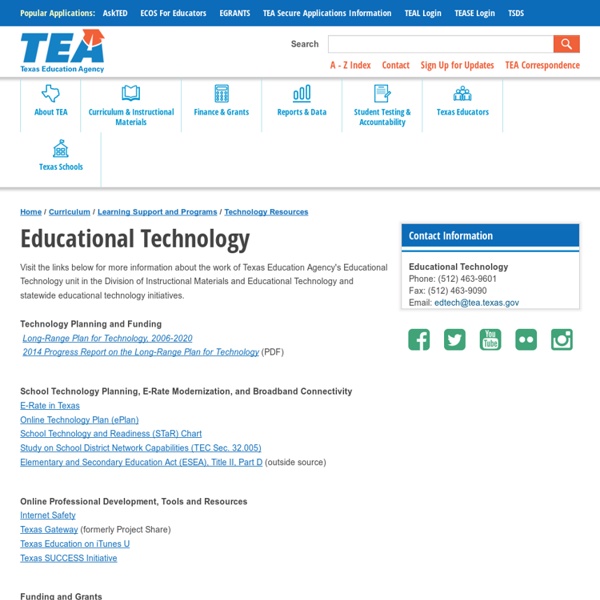Educational Technology
Visit the links below for more information about the work of Texas Education Agency's Educational Technology unit in the Division of Instructional Materials and Educational Technology and statewide educational technology initiatives. Technology Planning and Funding Long-Range Plan for Technology, 2006-2020 2014 Progress Report on the Long-Range Plan for Technology (PDF) School Technology Planning, E-Rate Modernization, and Broadband ConnectivityE-Rate in TexasOnline Technology Plan (ePlan)School Technology and Readiness (STaR) ChartStudy on School District Network Capabilities (TEC Sec. 32.005)Elementary and Secondary Education Act (ESEA), Title II, Part D (outside source) Funding and GrantsState Instructional Materials Allotment (IMA) Technology Lending Program Texas Education Agency Grant Opportunities Funding Digital Learning (outside source)Using Federal Funds to Support Transition to Digital Learning (outside source)Federal Grants (outside source)
Instructional Technology - Region 10 Website
Videoconference Services Videoconferencing Services Videoconference Bridging Content Capture, Archival and Streaming Video Scheduling and Help Desk Field Services and Support Training and Consulting Desktop / Device-based Videoconference services Requirements and Fees Professional Development Professional Development Information on Graduate Programs and College and University Guidelines Student Videoconferencing Students Dual credit high school courses High school courses in high need such as foreign languages Enrichment activities such as virtual field trips Project-based collaboration between classes Reggie's Robots utilizes VGo Robots to allow students to attend classes via interactive video conferencing while recovering from long-term illness, injury, or other factors requiring the student to be homebound or not able to be present in the classroom.
Tech Tools by Subject and Skills
Every year, so many new technology tools for teachers are launched into the market that it can be nearly impossible to keep up with them all. In order to keep you up-to-date with the latest and greatest educational tech tools, our team of edtech specialists has put together this list of the best edtech resources and technology tools for teachers. Clicking on the links below will take you to hundreds of apps, websites, extensions, and more. Also, if you have a tool that you'd like to see added to the list, please feel free to contact us at admin@edtechteacher.org. The following technology tools for teachers have been organized by academic subjects, topics, and learning activity.
Why Technology Alone Won't Fix Schools
For about a month in the spring of 2013, I spent my mornings at Lakeside School, a private school in Seattle whose students are the scions of the Pacific Northwest elite. The beautiful red-brick campus looks like an Ivy League college and costs almost as much to attend. The school boasts Bill Gates among its alumni, and its students come from the families of Amazon and Microsoft executives. Unsurprisingly, there is no dearth of technology: Teachers post assignments on the school’s intranet; classes communicate by email; and every student carries a laptop (required) and a smartphone (not). In this context, what do parents do when they think their children need an extra boost? All of the content I tutored is available on math websites and in free Khan Academy videos, and every student had round-the-clock Internet access. Lakeside parents are not unusual in their valuing of quality time with adults over technology. And what about computers outside of school?
Education Technology: Pictures, Videos, Breaking News
Office of Educational Technology
Neuman Celano library study: Educational technology worsens achievement gaps.
Courtesy of Shutterstock. The local name for the Philadelphia neighborhood of Kensington is “the Badlands,” and with good reason. Pockmarked with empty lots and burned-out row houses, the area has an unemployment rate of 29 percent and a poverty rate of 90 percent. Just a few miles to the northwest, the genteel neighborhood of Chestnut Hill seems to belong to a different universe. Here, educated professionals shop the boutiques along Germantown Avenue and return home to gracious stone and brick houses, the average price of which hovers above $400,000. Within these very different communities, however, are two places remarkably similar in the resources they provide: the local public libraries. The two were especially interested in how the introduction of computers might “level the playing field” for the neighborhoods’ young people, children of “concentrated affluence” and “concentrated poverty.”
School Technology.org
The 21st Century Learning Initiative ~ Home
Related:
Related:



